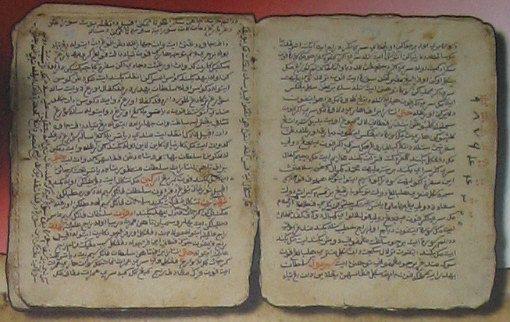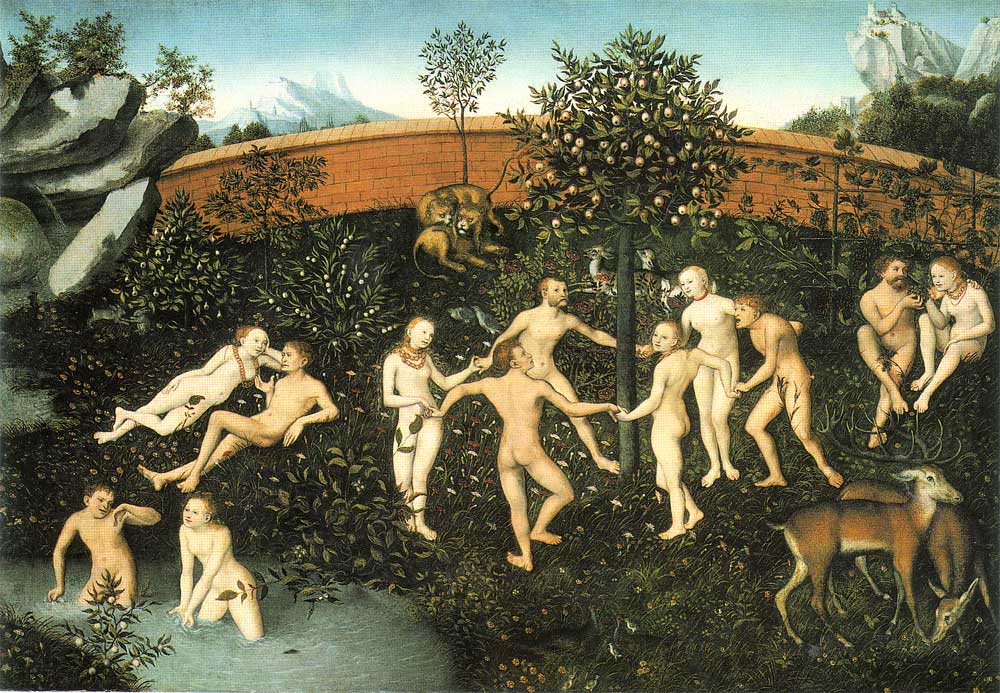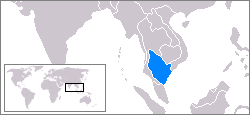|
Pattani Kingdom
Patani, or the Sultanate of Patani ( Jawi: كسلطانن ڤطاني) was a Malay sultanate in the historical Pattani Region. It covered approximately the area of the modern Thai provinces of Pattani, Yala, Narathiwat and part of the Malaysian state of Kelantan. The 2nd–15th century state of Langkasuka and the 6th–7th century state of Pan Pan may have been related. The golden age of Patani started during the reign of the first of its four successive queens, Raja Hijau (The Green Queen), who came to the throne in 1584 and was followed by Raja Biru (The Blue Queen), Raja Ungu (The Purple Queen) and Raja Kuning (The Yellow Queen). During this period the kingdom's economic and military strength was greatly increased to the point that it was able to fight off four major Siamese invasions. It had declined by the late 17th century and it was invaded by Siam in 1786, which eventually absorbed the state after its last raja was deposed in 1902. Predecessors An early kingdom ... [...More Info...] [...Related Items...] OR: [Wikipedia] [Google] [Baidu] |
Pattani, Thailand
Pattani is a town (''thesaban mueang'') in the far south of Thailand, near the border with Malaysia. It is the capital of Pattani Province. The city has a population of 44,353 (2018). It covers the whole ''tambon'' Sabarang, Anoru and Chabang Tiko of Mueang Pattani district. Pattani lies 1,056 km south of Bangkok, and is located at the mouth of the Pattani River. A small port is known to have existed at the river mouth Kuala Bekah in the 16th century. The historic centre of Patani was originally located a few miles away where the Krue Se Mosque is located. The older capital of Patani was captured and sacked by Siam in 1785. The local dialect of Malay is called Pattani Malay or Yawi in Thai (derived from Jawi). Etymology Some believe that the name ''Pattani'' originated from Malay name Patani ( Jawi: ڤطاني), which can mean "this beach" in Pattani Malay language. (In standard Malay, this would be ''pantai ini''.) According to a legend, the founder of Pattani was a ... [...More Info...] [...Related Items...] OR: [Wikipedia] [Google] [Baidu] |
Golden Age (metaphor)
A golden age is a period considered the peak in the history of a country or people, a time period when the greatness, greatest achievements were made. The term originated from early ancient Greece, Greek and ancient Rome, Roman poets, who used it to refer to a time when mankind lived in a better time and was pure (see Golden Age). The ancient Greek poet Hesiod introduced the term in his ''Works and Days'', when referring to the period when the "Golden Race" of man lived. This was part of fivefold division of Ages of Man, starting with the Golden age, then the Silver Age, the Bronze Age, the Greek Heroic Age, Age of Heroes (including the Trojan War), and finally, the current Iron Age. The concept was further refined by Ovid, in his ''Metamorphoses'', into the four "metal ages" (golden, silver, bronze, and iron). The Golden age in Classic literature The Golden age as described by Hesiod was an age where all humans were created directly by the Olympian gods. They lived long lives ... [...More Info...] [...Related Items...] OR: [Wikipedia] [Google] [Baidu] |
Ram Khamhaeng
Ramkhamhaeng (, ) or commonly known as Pho Khun Ramkhamhaeng Maharat (, ) was the third king of the Phra Ruang Dynasty, ruling the Sukhothai Kingdom (a historical kingdom of Thailand) from 1279 to 1298, during its most prosperous era. He is credited for the creation of the Thai alphabet and the firm establishment of Theravada Buddhism as the state religion of the kingdom.Chakrabongse, C., 1960, ''Lords of Life'', London: Alvin Redman Limited Birth and name Ramkhamhaeng (sometimes written Ram Khamhaeng) was a son of Pho Khun Bang Klang Hao, who ruled as Pho Khun Si Inthrathit, and his queen, Sueang,Prasert Na Nagara and Alexander B. Griswold (1992). "The Inscription of King Rāma Gāṃhèṅ of Sukhodaya (1292 CE)", p. 265, in ''Epigraphic and Historical Studies''. Journal of the Siam Society. The Historical Society Under the Royal Patronage of H.R.H. Princess Maha Chakri Sirindhorn: Bangkok. . though folk legend claims his real parents were an ogress named Kangli and a fis ... [...More Info...] [...Related Items...] OR: [Wikipedia] [Google] [Baidu] |
Nagarakretagama
The ''Nagarakretagama'' or ''Nagarakṛtāgama'', also known in Bali as ''Desawarnana'' or ''Deśavarṇana'', is an Old Javanese eulogy to Hayam Wuruk, a Javanese king of the Majapahit Empire. It was written on lontar as a ''kakawin'' by Mpu Prapanca in 1365 (1287 Saka year). The ''Nagarakretagama'' contains detailed descriptions of the Majapahit Empire during its greatest extent. The poem affirms the importance of Hindu–Buddhism in the Majapahit empire by describing temples and palaces and several ceremonial observances. The manuscript In 1894, the Dutch East Indies launched a military expedition against the Cakranegara royal house of Lombok. That year, the Dutch took the manuscript as part of the valuable '' Lombok treasure'', war booty from the destroyed palace of Mataram-Cakranagara in Lombok. The first Western scholar to study the manuscript was , a Dutch philologist. He accompanied the KNIL expedition to Lombok in 1894 and is credited with saving the valu ... [...More Info...] [...Related Items...] OR: [Wikipedia] [Google] [Baidu] |
Gulf Of Thailand
The Gulf of Thailand (), historically known as the Gulf of Siam (), is a shallow inlet adjacent to the southwestern South China Sea, bounded between the southwestern shores of the Indochinese Peninsula and the northern half of the Malay Peninsula. It is around in length and up to in width, and has a surface area of . The gulf is surrounded on the north, west and southwest by the coastlines of Thailand (hence the name), on the northeast by Cambodia and the Mekong Delta region of Vietnam, and opens to the South China Sea in the southeast. Names The modern Thai language, Thai name of the gulf is ''Ao Thai'' (, , 'Thai Gulf') and "Gulf of Thailand" has been adopted as the official name of the body by the International Hydrographic Organization. Its name in Malay language, Malay is "Gulf of Siam", ''Teluk Siam'' or in Jawi script: , and in '', Chhoung Samut Siem''. In Thai, the gulf is historically known as ''Ao Sayam'' (). In Vietnamese language, Vietnamese it is known as ''Vịn ... [...More Info...] [...Related Items...] OR: [Wikipedia] [Google] [Baidu] |
India
India, officially the Republic of India, is a country in South Asia. It is the List of countries and dependencies by area, seventh-largest country by area; the List of countries by population (United Nations), most populous country since 2023; and, since its independence in 1947, the world's most populous democracy. Bounded by the Indian Ocean on the south, the Arabian Sea on the southwest, and the Bay of Bengal on the southeast, it shares land borders with Pakistan to the west; China, Nepal, and Bhutan to the north; and Bangladesh and Myanmar to the east. In the Indian Ocean, India is near Sri Lanka and the Maldives; its Andaman and Nicobar Islands share a maritime border with Thailand, Myanmar, and Indonesia. Modern humans arrived on the Indian subcontinent from Africa no later than 55,000 years ago., "Y-Chromosome and Mt-DNA data support the colonization of South Asia by modern humans originating in Africa. ... Coalescence dates for most non-European populations averag ... [...More Info...] [...Related Items...] OR: [Wikipedia] [Google] [Baidu] |
Yijing (monk)
Yijing (635–713CE), formerly romanized as or , born Zhang Wenming, was a Tang-era Chinese Buddhist monk and renowned travel writer. His account of his travels are an important source for the history of the medieval kingdoms along the sea route between China and India, especially Srivijaya in Indonesia. He also gave accounts of the Gupta Period. A student of the Buddhist university at Nālandā (now in Bihar, India), he was also responsible for the translation of many Buddhist texts from Sanskrit and Pali into Chinese. Journey Srivijaya and Nālandā Yijing was born . He became a monk at age 14 and was an admirer of Faxian, a famed monk who traveled to India in the 4th and 5th centuries CE. Provided funding by an otherwise unknown benefactor named Fong, he decided to visit the renowned Buddhist university of Nālandā, in Bihar, India, to further study Buddhism. Traveling by a boat out of Guangzhou, he arrived in Srivijaya (today's Palembang in Sumatra) after 22 da ... [...More Info...] [...Related Items...] OR: [Wikipedia] [Google] [Baidu] |
Chinese People
The Chinese people, or simply Chinese, are people or ethnic groups identified with Greater China, China, usually through ethnicity, nationality, citizenship, or other affiliation. Chinese people are known as Zhongguoren () or as Huaren () by speakers of standard Chinese, including those living in Greater China as well as overseas Chinese. Although both terms both refer to Chinese people, their usage depends on the person and context. The former term is commonly (but not exclusively) used to refer to the citizens of the People's Republic of China—especially mainland China. The term Huaren is used to refer to ethnic Chinese, and is more often used for those who reside overseas or are non-citizens of China. The Han Chinese are the largest ethnic group in China, comprising approximately 92% of its Mainland China, Mainland population. [...More Info...] [...Related Items...] OR: [Wikipedia] [Google] [Baidu] |
Buddhist
Buddhism, also known as Buddhadharma and Dharmavinaya, is an Indian religion and List of philosophies, philosophical tradition based on Pre-sectarian Buddhism, teachings attributed to the Buddha, a wandering teacher who lived in the 6th or 5th century Before the Common Era, BCE. It is the Major religious groups, world's fourth-largest religion, with about 500 million followers, known as Buddhists, who comprise four percent of the global population. It arose in the eastern Gangetic plain as a movement in the 5th century BCE, and gradually spread throughout much of Asia. Buddhism has subsequently played a major role in Asian culture and spirituality, eventually spreading to Western world, the West in the 20th century. According to tradition, the Buddha instructed his followers in a path of bhavana, development which leads to Enlightenment in Buddhism, awakening and moksha, full liberation from ''Duḥkha, dukkha'' (). He regarded this path as a Middle Way between extremes su ... [...More Info...] [...Related Items...] OR: [Wikipedia] [Google] [Baidu] |
Hindu
Hindus (; ; also known as Sanātanīs) are people who religiously adhere to Hinduism, also known by its endonym Sanātana Dharma. Jeffery D. Long (2007), A Vision for Hinduism, IB Tauris, , pp. 35–37 Historically, the term has also been used as a geographical, cultural, and later religious identifier for people living in the Indian subcontinent. It is assumed that the term ''"Hindu"'' traces back to Avestan scripture Vendidad which refers to land of seven rivers as Hapta Hendu which itself is a cognate to Sanskrit term ''Sapta Sindhuḥ''. (The term ''Sapta Sindhuḥ'' is mentioned in Rig Veda and refers to a North western Indian region of seven rivers and to India as a whole.) The Greek cognates of the same terms are "''Indus''" (for the river) and "''India''" (for the land of the river). Likewise the Hebrew cognate ''hōd-dū'' refers to India mentioned in Hebrew BibleEsther 1:1. The term "''Hindu''" also implied a geographic, ethnic or cultural identifier for ... [...More Info...] [...Related Items...] OR: [Wikipedia] [Google] [Baidu] |
Raja Kuning
Raja Kuning or Ratu Kuning was the sovereign queen of Patani in the 17th century. Her name means "the Yellow Queen" in English. She succeeded her mother, Queen Raja Ungu. She was the last of four female rulers to have ruled in succession in the Patani Kingdom since 1584. She is the last queen regnant who is acknowledged as legitimate in the Patani chronicles. As Patani became less internationally attractive for traders in the late 17th century, sources about Patani history are scarce in that period. There is dispute over when her rule ended, and who succeeded her. Early life Raja Kuning was the daughter of Raja Ungu and the Sultan of Pahang. After the Sultan of Pahang died, she returned to Patani with her mother. She was said to be named Kuning (meaning "Yellow") because she had whitish-yellow skin. At the age of 12, she married Okphaya Déca, King of Bordelong Phatthalung, for an alliance between Patani kingdom and Ayutthaya kingdom. After Patani had break off relations with A ... [...More Info...] [...Related Items...] OR: [Wikipedia] [Google] [Baidu] |






